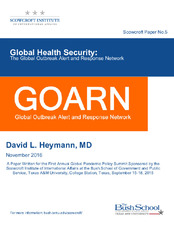| dc.description.abstract | : In the mid-1990s two infectious disease outbreaks – Pneumonic Plague in Surat, India and Ebola in Kikwit, Democratic Republic of Congo (then Zaire) - caused great concern globally. At that time the standard communication system of the World Health Organisation (WHO) - telephone, telex and facsimile – was unable to handle requests and information dissemination in a timely manner, resulting in uncertainty and misunderstanding that increased concern among its member countries. With a vision of using up-to-date communication technologies to avoid such problems in the future, the Global Outbreak Alert and Response Network (GOARN) was created. Its roots were in the World Health Organization’s (WHO’s) emerging infections programme established in 1966, and the goal of GOARN was to increase the sensitivity of global disease detection and the rapidity of global risk assessment, risk communication and outbreak response. By using the most up-to-date communications technologies, GOARN changed the way in which the WHO received, assessed, and responded to information about infectious disease outbreaks. | en |


